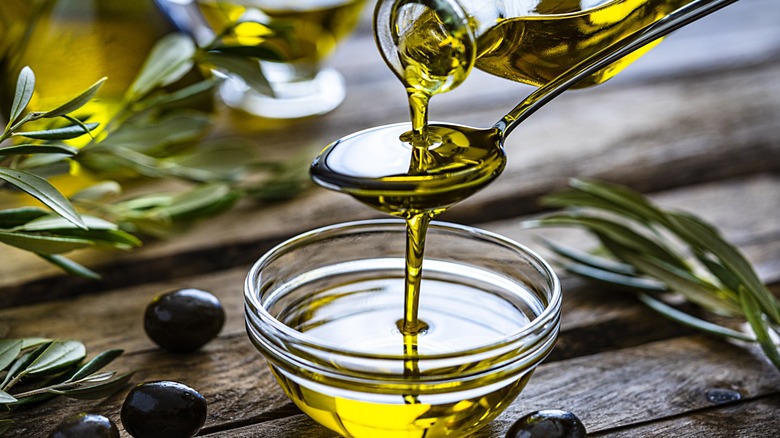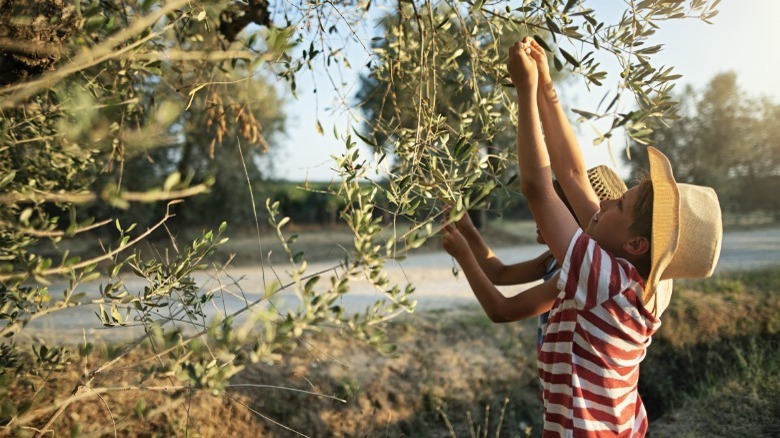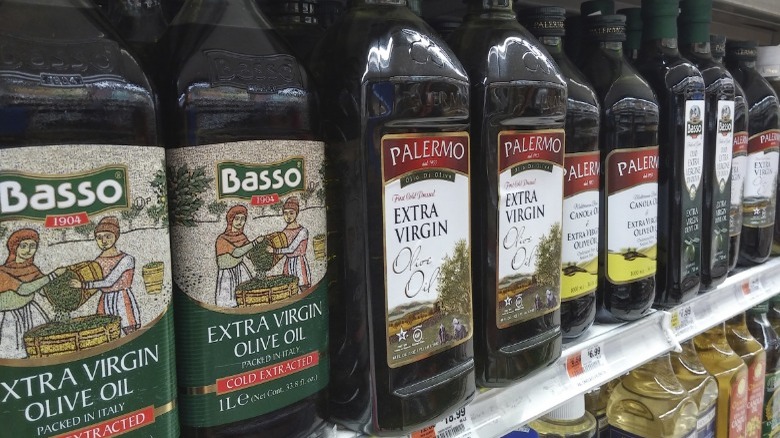Why You Should Make The Switch To Single-Sourced Olive Oil
While olive oil may appear to be a straightforward ingredient, there are actually a number of factors that go into determining its quality and, ultimately, its flavor profile. Much like there are sommeliers for wine, there are also sommeliers for olive oil, and one of their biggest tips for choosing first-class bottles has to do with where the ingredient comes from.
When it comes to origin, the experts recommend that you stick to what's called a single-sourced olive oil; for example, only from Italy or only from Spain. If there are a number of European countries listed on the bottle, it has little to do with excellence or luxury; rather, the oil is at its best closest to where it's first produced. Because, if your bottle has multiple locations on it, it simply means that the liquid is an amalgamation of oils from each location that are combined when they are ultimately bottled at a remote destination. Producers do this to save on costs on their end, and may also add seed oils that will further taint the purity.
Besides freshness, single-sourced oils also hold within them all of the unique characteristics of the region in which the olives were grown. Aspects like soil and climate have a major impact on the flavor, so sourcing the little fruits from one location keeps these flavor notes strong and clear, setting them apart from the crowd. Additionally, single-source oil gives the consumer the ability to know exactly where the ingredient came from, down to the specific farm, allowing for more transparent purchasing practices.
Where do the best olive oils in the world come from?
When it comes to where the best single-sourced olive oil can be traced to, there isn't one obvious answer. Olive trees are a Mediterranean plant, so they grow ideally in locations with sunny and hot summers and mild winters. In Europe, Italy, Spain, and Greece are three countries that are well-known for their olive oil production. Considering their cuisines — think Italian pastas and traditional Greek dishes like moussaka — it makes sense that these locations would have top-notch oils.
More specifically, Spain is a top exporter of olive oil with Italy close behind it. The Jaén province in Spain produces the most oils in the country; in Italy, the provinces of Calabria and Apulia take the production cake. More than 350 kinds of olives are grown in Italy, with each having its own flavor profile and qualities that give Italian olive oils their unique taste. Greeks are actually the biggest consumers of the liquid in the world, with each person consuming 24 liters of the liquid on average every year, per World Population Review.
The States aren't foreign to the business of oil production either, as the liquid has been made here for over 150 years. Bottles are produced in states like California, Arizona, Texas, and Georgia, with around 40,000 acres of olive trees planted in the United States overall. And, Americans use 90 million gallons of olive oil every year, which is the largest amount outside of Europe.
Other key things to know about olive oil quality
Besides switching to single-source olive oil, there are some other key things to keep in mind when purchasing a bottle, to ensure you're bringing home the creme de la creme. In terms of packaging, stick to oils sold in dark glass bottles. Olive oil is corrosive to plastics over time, and light can impact its quality, so steering clear of plastic bottles is essential. Another measure of merit is harvest date — oil will be best when consumed within 18 months of this date. Top notch oil has a distinctly "green" taste and smell, but outside of this time period, the liquid can become rancid and lose its important antioxidant properties.
Some also prefer minimally processed extra virgin oil because it retains more antioxidant properties, but a study done by UC Davis showed that 69% of olive oils that claimed to be extra virgin didn't actually meet the scientific standards for the classification. If you want to ensure your oil is extra virgin, the viral refrigerator test for olive oil won't cut it. Instead, it's best to look for reliable third party certification seals, like the European Union's Protected Designation of Origin (PDO), Italy's DOP, or the California Olive Oil Council's "Certified Extra Virgin" seal. If you see an extra virgin variety made in Australia or Chile, you can trust that it's pure. Australia has strict requirements to earn the designation, and neither country allows the blending of olive and seed oils.



